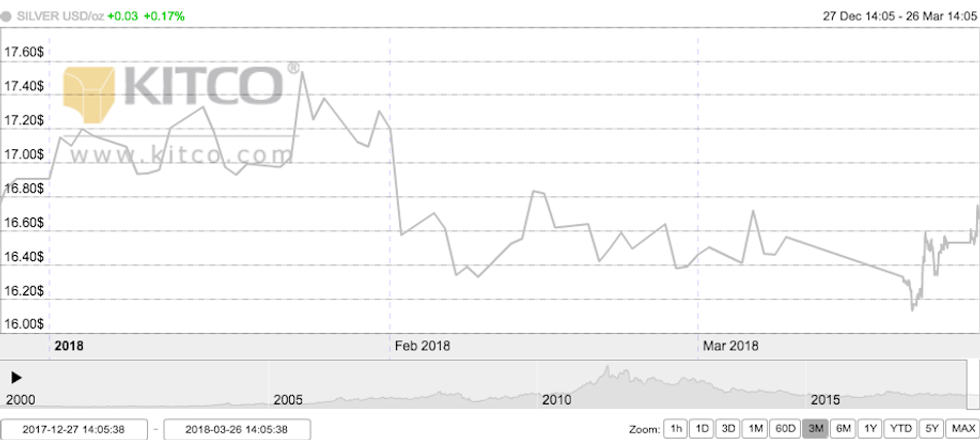What happened to silver in Q2 2018? Our silver price update outlines key market developments and explores what could happen moving forward.
The price of silver fell more than 1.96 percent in the second quarter, dipping below the US$17.00 safety benchmark towards the end of April, where it would stay for the remainder of Q2.
A strong US dollar, stagnant investor demand and silver’s inability to attract the height of safe-haven demand that has supported gold, stifled silver in the second quarter. While gains were made on the back of geopolitical concerns at the beginning of Q2, much like the situation with gold, investors were not interested in holding the precious metal in their portfolios during market uncertainty.
Despite silver’s performance in Q2, many industry insiders believe that it will rebound by becoming a more appealing safe-haven commodity and from its growing demand through solar panel and jewellery consumption. Insiders see the white metal increasing towards the end of September and in the perfect position to finally outperform gold.
Read on for an overview of the factors that impacted the silver market in Q2, plus a look at what investors should watch out for in the next few months of the year.
Silver price update: Q2 overview
The price of silver slid 1.96 percent in the second quarter. As the chart below from Kitco shows, the metal experienced mostly declines during the period, but reached its lowest point at the beginning of May.
Chart via Kitco
Silver hit its lowest point in Q2 on May 1, trading at US$16.14 per ounce. The metal decreased on the back of a strengthened US dollar. Also at this time, the gold/silver ratio climbed back up to 80 after briefly falling to 70.
When compared to silver’s lowest point of US$17.54 in Q1 2018, the metal’s struggle in the second quarter becomes even more apparent.
Meanwhile, the precious metal found its highest point on the morning of April 19, reaching US$17.22. On that day, prices built on the 2.5 month-high the metal experienced in the previous session due to technical trading and a weaker US dollar.
Silver price update: Key drivers
As the third quarter of the year begins, investors interested in the silver market should be aware of a number of factors that could impact the precious metal’s price.
Most analysts agree that the greenback’s movements, geopolitical tensions and growing demand will be key drivers for the silver price for 2018.
With the US dollar consistently increasing throughout the second quarter, any gains that the white metal made were consistently pulled down, dwindling investor confidence in the metal.
“On various occasions over the past few years, silver prices have risen only to fall back. This sort of price pattern often turns investors away, putting them in a cautionary, wait and see frame of mind,” the CPM Group stated.
Similarly, panelists at FocusEconomics stated, “[d]ownward price pressures stem from a strengthening of the dollar, which reduce[s] safe-haven inflows into silver and dampens prices.”
“When investors are not so hot on precious metals, silver declines faster than gold, so I am not surprised that silver is weak, now that the dollar is rallying,” added Ivan Martchev, investment advisor at Navellier & Associates.
The second Fed hike of the year also played a role in the price of silver.
While the white metal rose immediately after the Federal Reserve officially announced that they would be lifting the target federal funds rate by 25 basis points, from 1.75 percent to 2 percent, the increase did not last long.
Later that day, the US dollar rose and silver tumbled.
Byron King of Agora Financial told the Investing News Network (INN), “[t]he dollar strengthened due to the US Fed increasing interest rates, and Fed taking heads issuing guidance to expect more rate increases at regular intervals. Plus, global markets appear to perceive strong economic growth in the US, leading to a bid-up for dollars.”
Geopolitical tensions also drove the white metal in Q2, allowing it to make small gains throughout the quarter.
During times of market upset caused by political insecurity, the US dollar goes down and makes precious metals cheaper to hold. Although many investors turn to gold when this happens, the fact that silver is the cheaper of the two metals creates an uptick in interest as well.
“In my experience, when precious metals are seeing strong investor interest, silver tends to outperform gold. This is because “poor man’s gold,” as silver is sometimes called, is a smaller market and therefore it is easier to move,” said Martchev.
Two of the largest geopolitical issues of Q2 have been the ongoing trade war concerns between the US and China and US president Donald Trump’s tariff spree on several countries.
“US President Donald Trump’s “America First” policies and the imposition of tariffs have caused deep diplomatic riffs among traditional G7 allies and kicked off a series of tit-for-tat tariff retaliations in recent weeks,” said analysts at FocusEconomics.
However, Q2 also saw a lack of interest in precious metals as safe-havens, which caused gains to be short-lived, and, for the most part, insignificant.
“What we are seeing is a serious lack of large investor and institutional interest in the metals and mining sector. In my opinion, the major US and Canadian markets are topping, emerging markets are falling and all markets are being whipsawed by a petulant vindictive man-child with no real plan or interest in factual data,” Brent Cook of Exploration Insights told INN.
Finally, on a positive note, industrial demand for silver, led by photovoltaic growth stemming from the increased use of solar panels was a catalyst for silver in Q2.
“The use of silver in solar photovoltaic panels has grown rapidly. Solid demand from the semi-conductor market, lifted by a strong global economy, has led to higher silver off take in electrical and electronics applications. Global supply is continuing to tighten due to lower mine supply and declining global silver scrap supply, which will exert upward pressure on prices,” said FocusEconomics.
Nihad Ahmed, economist at FocusEconomics told INN, “[r]ising demand for silver has also emanated from the high-tech auto industry. Tightening global supply due to lower mining output and declining global silver scrap supply have also exerted upward pressure on prices.”
He added, “[s]upply disruptions in the Americas, notably in Guatemala, have constrained the total production of silver.”
This boost from silver use in solar panels created an uptick in fabrication demand during the second quarter.
“Fabrication demand continues to be solid, driven by solar and the electrical components and also some other pockets of the market are showing modest but positive growth,” Johan Wiebe, lead metals analyst at Thomson Reuters told INN.
Silver price update: What’s ahead?
Many industry insiders predict that silver will stay the course for the third quarter this year, eventually beginning its slow climb as markets enter into the fourth quarter.
According to Wiebe, he believes that silver will endure its current position for the next few months and will not rebound as quickly as gold.
“Silver’s industrial base is making it act more like a base metal than gold at present and although we do see it basing out with gold, we expect it to continue to tread cautiously while industrial uncertainty persists,” he told INN.
Analysts at Scotiabank (TSX:BNS, NYSE:BNS) agree with Wiebe’s observations, stating, “[g]oing forward, we expect that recuperating physical bar demand and rising industrial consumption will help tighten markets and push speculators, who remain net short silver, out of the market.”
Adding, “silver prices are expected to average US$18 per ounce this year and rise to US$19 per ounce in 2019 on the dual precious/industrial nature of its demand base.”
Ahmed stated, “[l]ooking ahead, FocusEconomics Consensus Forecast panelists expect prices to rise moderately this year, averaging US$17.2 per troy ounce in the final quarter of 2018.”
Adding, “[r]educed supply and growing demand for industrial applications are expected to boost silver prices. Increased volatility in financial markets stemming from heightened geopolitical uncertainties, along with anticipated higher jewelry demand, will also put upward pressure on prices.”
While Ed Steer of Ed Steer’s Gold and Silver Digest does not give a predicted price for the white metal, he agrees with other insiders and analysts that silver will find its footing and prices will eventually rally.
“We’ll certainly have “new and improved” precious metal prices before the year is out,” he told INN.
David Morgan of The Morgan Report shares Steer’s sentiments, telling INN, “[p]recious metals should gain strength late in the third quarter and moving into the final months of this year.”
FocusEconomics panelists estimate that the average silver price for Q3 2018 will be US$17.00. The most bullish forecast for the quarter comes from both Société Générale (EPA:GLE) and ANZ (ASX:ANZ), which are calling for a price of US$18.80; meanwhile, ABN AMRO (EPA:ABN) is the most bearish with a forecast of US$16.00.
Don’t forget to follow us @INN_Resource for real-time news updates!
Securities Disclosure: I, Nicole Rashotte, hold no direct investment interest in any company mentioned in this article.
Editorial Disclosure: The Investing News Network does not guarantee the accuracy or thoroughness of the information reported in the interviews it conducts. The opinions expressed in these interviews do not reflect the opinions of the Investing News Network and do not constitute investment advice. All readers are encouraged to perform their own due diligence.
This article is updated each quarter. Please scroll the top for the most recent information.
Silver Price Update: Q1 2018 in Review
By Nicole Rashotte, March 27, 2018
The silver price made gains of 0.21 percent in the first quarter of the year, supported by a weaker US dollar and inflation.
While gains were initially offset by expectations of a US Federal Reserve interest rate hike, silver headed in an upward motion in March after the hike became official.
In addition to the factors mentioned above, analysts also predict that a silver supply deficit this year will prop up prices.
Read on for an overview of the factors that impacted the silver market in Q1, plus a look at what investors should watch out for in the next few months of the year.
Silver price update: Q1 overview
As mentioned, the silver price rose 0.21 percent in Q1. As the chart below from Kitco shows, the white metal experienced several ups and downs, but reached its highest level toward the end of January.
Chart via Kitco.
The precious metal found its highest point on January 24, reaching US$17.54 per ounce. It increased 0.2 percent that day, finding support when the US dollar hit a three-year low after comments that US Treasury Secretary Steven Mnuchin welcomed a weaker currency.
Meanwhile, silver fell to its lowest point of the quarter on March 20, trading at US$16.14. The gray metal hit this low when the US dollar strengthened ahead of the Fed’s interest rate hike. That’s because higher rates tend to curb the appeal of holding non-yielding assets such as silver.
Silver price update: Factors to watch
As the second quarter of the year begins, investors interested in the silver market should be aware of a number of factors that could impact the precious metal’s price.
Much like gold, most analysts agree that political uncertainty, the state of the US dollar and increased interest rates will continue to be key drivers for the silver price in 2018.
In terms of political uncertainty, analysts at FocusEconomics stated, “[t]he recent upturn in prices came as President Trump decided to impose hefty tariffs on imported steel and aluminum, shaking up markets and intensifying fears of a full-blown trade war. This fueled more safe-haven demand for silver.”
Brien Lundin, editor at Gold Newsletter, also addressed the tariffs, stating, “I think they’re terrible. They’re a terrible idea. I think it creates uncertainty, which creates volatility in the market.” Volatility in the market often brings investors to safe havens such as precious metals.
While gold is typically an investor’s first choice in a shaky market, Dr. Kal Kotecha, editor and founder of the Junior Gold Report, said “silver [is] taking on a lot of base metal characteristics as well and being a cheap man’s gold. I believe it’s [going to] propel itself quite a bit higher. So when gold starts moving on a percentage basis, silver will accelerate that, and it is only so long you can submerge something.”
Other political concerns stem from US President Trump’s chaotic administration. On Friday (March 16), departures of two key officials, former Secretary of State Rex Tillerson and top economic advisor Gary Cohn, left investors worried. This political disruption resulted in a weakened greenback, which made bullion cheaper for holders of other currencies.
Increased interest rates also drove silver prices during the first quarter, as the Fed and interest hikes took on a major role toward the end of Q1.
As forecast towards the end of Q3 last year, three interest hikes were proposed for 2018, the first of which took place on March 21. Like gold, silver faced a fall before the Fed implemented the hike, but then experienced gains on the back of the announcement.
According to Bilal Hafeez, strategist at Nomura, the US dollar’s movements prior to a hike “are all about expectations,” and that is what pushes it up while commodities like silver fall. “Indeed, the dollar has followed a pattern of trading relatively well into Fed hikes, but selling off after,” he noted.
Kitco’s Jim Wyckoff said, “selling pressure in gold and silver occurred because traders reckoned a US rate hike would be bearish for the metals. And when the rate hike actually occurred, the metals moved higher because the sellers were already exhausted and had played out their rate-hike hand.”
With two more hikes forecast for 2018 and a steeper outline for hikes in 2019 and 2020, there will be many opportunities for investors to turn their attention to bullion, forcing prices upward.
Shifting away from its comparison to gold, demand for silver from industrial applications continues to grow, lifting the price of the metal up.
“Along with a decline in global mine supply, stronger demand for industrial usage of silver from solar panel makers and the auto sector as it moves towards increased electrification, has placed upward pressure on prices,” said analysts for FocusEconomics.
In a report released on January 18, Michael DiRienzo, executive director of the Silver Institute, said “[s]trong industrial demand, jewelry demand and renewed investor interest will continue to support the market as mine production could decline for the second consecutive year by 2 percent in 2018.”
Silver price update: What’s ahead?
Many industry insiders acknowledge the struggle that silver has experienced in Q1, but still predict a bullish year for the gray metal.
According to panelists at FocusEconomics, “[p]rices are expected to rise this year as supply remains constrained and demand from industrial applications continues to grow. Expectations of higher jewelry demand and higher volatility in financial markets are also seen driving up prices.”
Similarly, Fred Davidson, president and CEO of IMPACT Silver (TSXV:IPT), said at PDAC that he believes the price of silver will continue to trend upwards.
He did not provide an exact estimate, but did say there is a problem with current silver pricing. “Silver is much stronger than it was. But certainly, there’s a bit of weakness in the pricing of silver,” he said.
David Morgan of the Morgan Report is a true believer in silver and its capability to not only increase in price, but outperform gold as well.
“I think this year silver will outperform gold. I could see a 30-percent increase in the price of silver from the bottom, and maybe something similar in gold from last year — 10 to 20 percent. Those are modest numbers relative to what gold can do. But if you compound your money at 20 percent, you could make a fortune over a few years, really,” Morgan said.
Bart Melek of Canadian brokerage TD Securities also forecasts that silver will outperform gold in 2018. “Considering silver’s underperformance, its traditionally higher volatility and historic relative strength during periods when investors are building gold exposure, the white metal is on track to outperform,” Melek stated.
Melek predicts that the average gold price will land at US$1,313 per ounce, while silver will trade at US$18.88 in 2018. That would put the gold/silver ratio just below 70.
FocusEconomics panelists estimate that the average silver price for Q2 2018 will be US$17.10. The most bullish forecasts for the quarter come from ANZ and BMO Capital Markets, both of which are calling for a price of US$18.20; meanwhile, Natixis is the most bearish with a forecast of US$16.
Don’t forget to follow us @INN_Resource for real-time news updates!
Securities Disclosure: I, Nicole Rashotte, hold no direct investment interest in any company mentioned in this article.







